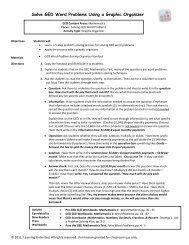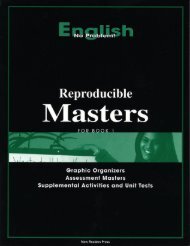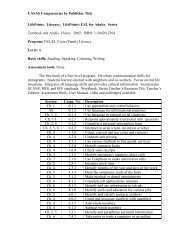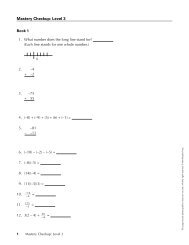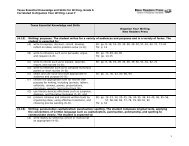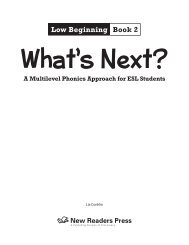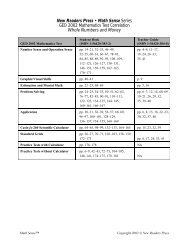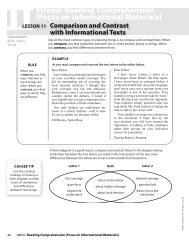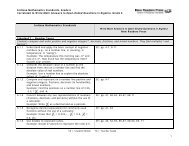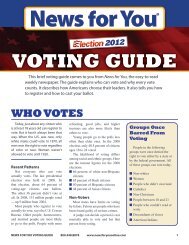English-Language Arts Content Standards for California Public ...
English-Language Arts Content Standards for California Public ...
English-Language Arts Content Standards for California Public ...
You also want an ePaper? Increase the reach of your titles
YUMPU automatically turns print PDFs into web optimized ePapers that Google loves.
<strong>English</strong>-<strong>Language</strong> <strong>Arts</strong> <strong>Content</strong> <strong>Standards</strong> <strong>for</strong> Cali<strong>for</strong>nia <strong>Public</strong> Schools, Grade 7Correlated to Respond to Literature, Level G<strong>English</strong>-<strong>Language</strong> <strong>Arts</strong> <strong>Content</strong> <strong>Standards</strong>Writing1.0 Writing StrategiesOrganization and Focus1.1 Create an organizational structure that balances allaspects of the composition and uses effectivetransitions between sentences to unify importantideas.1.2 Support all statements and claims with anecdotes,descriptions, facts and statistics, and specificexamples.1.3 Use strategies of note taking, outlining, andsummarizing to impose structure on compositiondrafts.Research and Technology1.4 Identify topics; ask and evaluate questions; anddevelop ideas leading to inquiry, investigation, andresearch.1.5 Give credit <strong>for</strong> both quoted and paraphrasedin<strong>for</strong>mation in a bibliography by using a consistentand sanctioned <strong>for</strong>mat and methodology <strong>for</strong>citations.1.6 Create documents by using word-processing skillsand publishing programs; develop simple databasesand spreadsheets to manage in<strong>for</strong>mation andprepare reports.Evaluation and Revision1.7 Revise writing to improve organization and wordchoice after checking the logic of the ideas and theprecision of the vocabulary.Respond to LiteratureNew Readers PressSE: pp. 15, 16, 27, 39, 53, 66, 67, 78, 79, 90TG: pp. 7, 10, 13, 15SE: pp. 10–11, 23–25, 36–37, 62–63, 74–75, 88, 90TG: pp. 7, 8, 11, 13SE: pp. 13, 14, 25, 26, 37, 38, 51, 52, 64, 65, 77, 88, 89,TG: pp. 7, 10, 15SE: pp. 17–18, 30–31, 42–43, 56–57, 69–70, 81–82, 93–94TG: pp. 7, 9SE = Student Edition TG = Teacher Guide1
<strong>English</strong>-<strong>Language</strong> <strong>Arts</strong> <strong>Content</strong> <strong>Standards</strong> <strong>for</strong> Cali<strong>for</strong>nia <strong>Public</strong> Schools, Grade 7Correlated to Respond to Literature, Level G<strong>English</strong>-<strong>Language</strong> <strong>Arts</strong> <strong>Content</strong> <strong>Standards</strong>Respond to LiteratureNew Readers Pressc. Include evidence compiled through the <strong>for</strong>malresearch process (e.g., use of a card catalog,Reader’s Guide to Periodical Literature, acomputer catalog, magazines, newspapers,dictionaries).d. Document reference sources by means offootnotes and a bibliography.2.4 Write persuasive compositions:a. State a clear position or perspective in supportof a proposition or proposal.b. Describe the points in support of theproposition, employing well-articulatedevidence.c. Anticipate and address reader concerns andcounterarguments.2.5 Write summaries of reading materials:a. Include the main ideas and most significantdetails.b. Use the student’s own words, except <strong>for</strong>quotations.c. Reflect underlying meaning, not just thesuperficial details.Written and Oral <strong>English</strong> <strong>Language</strong> Conventions1.0 Written and Oral <strong>English</strong> <strong>Language</strong> ConventionsSentence Structure1.1 Place modifiers properly and use the active voice. TG: p. 10Grammar1.2 Identify and use infinitives and participles and makeclear references between pronouns andantecedents.SE = Student Edition TG = Teacher Guide3
<strong>English</strong>-<strong>Language</strong> <strong>Arts</strong> <strong>Content</strong> <strong>Standards</strong> <strong>for</strong> Cali<strong>for</strong>nia <strong>Public</strong> Schools, Grade 7Correlated to Respond to Literature, Level G<strong>English</strong>-<strong>Language</strong> <strong>Arts</strong> <strong>Content</strong> <strong>Standards</strong>Respond to LiteratureNew Readers Press1.3 Identify all parts of speech and types and structureof sentences.1.4 Demonstrate the mechanics of writing (e.g.,quotation marks, commas at end of dependentclauses) and appropriate <strong>English</strong> usage (e.g.,pronoun reference).Punctuation1.5 Identify hyphens, dashes, brackets, and semicolonsand use them correctly.Capitalization1.6 Use correct capitalization.Spelling1.7 Spell derivatives correctly by applying the spellingsof bases and affixes.SE = Student Edition TG = Teacher Guide4
<strong>English</strong>-<strong>Language</strong> <strong>Arts</strong> <strong>Content</strong> <strong>Standards</strong> <strong>for</strong> Cali<strong>for</strong>nia <strong>Public</strong> Schools, Grade 8Correlated to Respond to Literature, Level H<strong>English</strong>-<strong>Language</strong> <strong>Arts</strong> <strong>Content</strong> <strong>Standards</strong>Respond to Literature,New Readers PressWriting1.0 Writing StrategiesOrganization and Focus1.1 Create compositions that establish a controllingimpression, have a coherent thesis, and end with aclear and well-supported conclusion.1.2 Establish coherence within and among paragraphsthrough effective transitions, parallel structures,and similar writing techniques.1.3 Support theses or conclusions with analogies,paraphrases, quotations, opinions from authorities,comparisons, and similar devices.Research and Technology1.4 Plan and conduct multiple-step in<strong>for</strong>mationsearches by using computer networks and modems.1.5 Achieve an effective balance between researchedin<strong>for</strong>mation and original ideas.Evaluation and Revision1.6 Revise wording <strong>for</strong> word choice; appropriateorganization; consistent point of view; andtransitions between paragraphs, passages, andideas.2.0 Writing Applications (Genres and Their Characteristics)2.1 Write biographies, autobiographies, short stories, ornarratives:a. Relate a clear, coherent incident, event, orsituation by using well-chosen details.b. Reveal the significance of, or the writer’s attitudeabout, the subject.SE: pp. 14, 26, 38, 50, 63, 75, 87TG: pp. 7, 10SE: pp. 15, 64, 76SE: pp. 6, 10–12, 23–24, 36, 46–48, 58–61, 72–73, 83–85TG: p. 12SE: pp. 17–18, 29–30, 41–42, 53–54, 66–67, 78–79, 90–92TG: p. 12SE = Student Edition TG = Teacher Guide1
<strong>English</strong>-<strong>Language</strong> <strong>Arts</strong> <strong>Content</strong> <strong>Standards</strong> <strong>for</strong> Cali<strong>for</strong>nia <strong>Public</strong> Schools, Grade 8Correlated to Respond to Literature, Level H<strong>English</strong>-<strong>Language</strong> <strong>Arts</strong> <strong>Content</strong> <strong>Standards</strong>Respond to Literature,New Readers Pressc. Employ narrative and descriptive strategies(e.g., relevant dialogue, specific action, physicaldescription, background description, comparisonor contrast of characters).2.2 Write responses to literature: SE: pp. 8–19, 20-31, 32-43,44-55, 56-68, 69-80, 81-93,TG: pp. 7-8, 8-9, 10-11, 11-12, 12-13, 13-14,14-16a. Exhibit careful reading and insight in theirinterpretations.b. Connect the student’s own responses to thewriter’s techniques and to specific textualreferences.c. Draw supported inferences about the effects of aliterary work on its audience.d. Support judgments through references to thetext, other works, other authors, or to personalknowledge.2.3 Write research reports:a. Define a thesis.b. Record important ideas, concepts, and directquotations from significant in<strong>for</strong>mation sourcesand paraphrase and summarize all perspectiveson the topic, as appropriate.c. Use a variety of primary and secondary sourcesand distinguish the nature and value of each.d. Organize and display in<strong>for</strong>mation on charts,maps, and graphs.SE: pp. 6, 10–12, 23–24, 36, 46–48, 58–61, 72–73, 83–85TG: p. 12SE: pp. 11–12, 24, 36, 61TG: p. 9SE = Student Edition TG = Teacher Guide2
<strong>English</strong>-<strong>Language</strong> <strong>Arts</strong> <strong>Content</strong> <strong>Standards</strong> <strong>for</strong> Cali<strong>for</strong>nia <strong>Public</strong> Schools, Grade 8Correlated to Respond to Literature, Level H<strong>English</strong>-<strong>Language</strong> <strong>Arts</strong> <strong>Content</strong> <strong>Standards</strong>Respond to Literature,New Readers Press2.4 Write persuasive compositions:a. Include a well-defined thesis (i.e., one thatmakes a clear and knowledgeable judgment).b. Present detailed evidence, examples, andreasoning to support arguments, differentiatingbetween facts and opinion.c. Provide details, reasons, and examples,arranging them effectively by anticipating andanswering reader concerns andcounterarguments.2.5 Write documents related to career development,including simple business and job applications:a. Present in<strong>for</strong>mation purposefully and succinctlyand meet the needs of the intended audience.b. Follow the conventional <strong>for</strong>mat <strong>for</strong> the type ofdocument (e.g., letter of inquiry,memorandum).2.6 Write technical documents:a. Identify the sequence of activities needed todesign a system, operate a tool, or explain thebylaws of an organization.b. Include all factors and variables that need to beconsidered.c. Use <strong>for</strong>matting techniques (e.g., headings,different fonts) to aid comprehension.Written and Oral <strong>English</strong> <strong>Language</strong> Conventions1.0 Written and Oral <strong>English</strong> <strong>Language</strong> ConventionsSentence Structure1.1 Use correct and varied sentence types and sentenceopenings to present a lively and effective personalstyle.TG: p. 15SE = Student Edition TG = Teacher Guide3
<strong>English</strong>-<strong>Language</strong> <strong>Arts</strong> <strong>Content</strong> <strong>Standards</strong> <strong>for</strong> Cali<strong>for</strong>nia <strong>Public</strong> Schools, Grade 8Correlated to Respond to Literature, Level H<strong>English</strong>-<strong>Language</strong> <strong>Arts</strong> <strong>Content</strong> <strong>Standards</strong>Respond to Literature,New Readers Press1.2 Identify and use parallelism, including similargrammatical <strong>for</strong>ms, in all written discourse topresent items in a series and items juxtaposed <strong>for</strong>emphasis.1.3 Use subordination, coordination, apposition, andother devices to indicate clearly the relationshipbetween ideas.Grammar1.4 Edit written manuscripts to ensure that correctgrammar is used.Punctuation and Capitalization1.5 Use correct punctuation and capitalization.Spelling1.6 Use correct spelling conventions.SE = Student Edition TG = Teacher Guide4
<strong>English</strong>-<strong>Language</strong> <strong>Arts</strong> <strong>Content</strong> <strong>Standards</strong> <strong>for</strong> Cali<strong>for</strong>nia <strong>Public</strong> Schools, Grade 9Correlated to Respond to Literature, Level I<strong>English</strong>-<strong>Language</strong> <strong>Arts</strong> <strong>Content</strong> <strong>Standards</strong>Writing1.0 Writing StrategiesOrganization and Focus1.1 Establish a controlling impression or coherent thesisthat conveys a clear and distinctive perspective onthe subject and maintain a consistent tone andfocus throughout the piece of writing.1.2 Use precise language, action verbs, sensory details,appropriate modifiers, and the active rather thanthe passive voice.Research and Technology1.3 Use clear research questions and suitable researchmethods (e.g., library, electronic media, personalinterview) to elicit and present evidence fromprimary and secondary sources.1.4 Develop the main ideas within the body of thecomposition through supporting evidence (e.g.,scenarios, commonly held beliefs, hypotheses,definitions).1.5 Synthesize in<strong>for</strong>mation from multiple sources andidentify complexities and discrepancies in thein<strong>for</strong>mation and the different perspectives found ineach medium (e.g., almanacs, microfiche, newssources, in-depth field studies, speeches, journals,technical documents).1.6 Integrate quotations and citations into a writtentext while maintaining the flow of ideas.Respond to Literature,New Readers PressSE: pp. 15, 29, 41, 55, 68, 80, 92, 104TG: pp. 7, 8SE: pp. 16, 30, 33, 42, 45, 56, 69, 74, 81, 93, 105TG: pp. 11, 18SE: pp. 10–13, 23–27, 37–39, 51–53, 63–66, 76–78, 88–90,100–102TG: pp. 10, 13, 15SE = Student Edition TG = Teacher Guide1
<strong>English</strong>-<strong>Language</strong> <strong>Arts</strong> <strong>Content</strong> <strong>Standards</strong> <strong>for</strong> Cali<strong>for</strong>nia <strong>Public</strong> Schools, Grade 9Correlated to Respond to Literature, Level I<strong>English</strong>-<strong>Language</strong> <strong>Arts</strong> <strong>Content</strong> <strong>Standards</strong>Respond to Literature,New Readers Press1.7 Use appropriate conventions <strong>for</strong> documentation inthe text, notes, and bibliographies by adhering tothose in style manuals (e.g., Modern <strong>Language</strong>Association Handbook, The Chicago Manual ofStyle).1.8 Design and publish documents by using advancedpublishing software and graphic programs.Evaluation and Revision1.9 Revise writing to improve the logic and coherenceof the organization and controlling perspective, theprecision of word choice, and the tone by takinginto consideration the audience, purpose, and<strong>for</strong>mality of the context.2.0 Writing Applications (Genres and Their Characteristics)2.1 Write biographical or autobiographical narratives orshort stories:a. Relate a sequence of events and communicatethe significance of the events to the audience.b. Locate scenes and incidents in specific places.c. Describe with concrete sensory details thesights, sounds, and smells of a scene and thespecific actions, movements, gestures, andfeelings of the characters; use interiormonologue to depict the characters’ feelings.d. Pace the presentation of actions toaccommodate changes in time and mood.e. Make effective use of descriptions ofappearance, images, shifting perspectives, andsensory details.SE: pp. 18–19, 32–33, 44–45, 58–59, 71–72, 83–84, 95–96,107–108TG: p. 16SE = Student Edition TG = Teacher Guide2
<strong>English</strong>-<strong>Language</strong> <strong>Arts</strong> <strong>Content</strong> <strong>Standards</strong> <strong>for</strong> Cali<strong>for</strong>nia <strong>Public</strong> Schools, Grade 9Correlated to Respond to Literature, Level I<strong>English</strong>-<strong>Language</strong> <strong>Arts</strong> <strong>Content</strong> <strong>Standards</strong>Respond to Literature,New Readers Press2.2 Write responses to literature: SE: pp. 8-20, 21-34, 35-46, 47-60, 61-73, 74-85, 86-97, 98-109TG: pp. 7-8, 8-10, 10-11, 11-13, 13-14, 15-16, 16-17, 17-18a. Demonstrate a comprehensive grasp of thesignificant ideas of literary works.b. Support important ideas and viewpoints throughaccurate and detailed references to the text or toother works.c. Demonstrate awareness of the author’s use ofstylistic devices and an appreciation of theeffects created.d. Identify and assess the impact of perceivedambiguities, nuances, and complexities withinthe text.2.3 Write expository compositions, including analyticalessays and research reports:a. Marshal evidence in support of a thesis andrelated claims, including in<strong>for</strong>mation on allrelevant perspectives.b. Convey in<strong>for</strong>mation and ideas from primary andsecondary sources accurately and coherently.c. Make distinctions between the relative value andsignificance of specific data, facts, and ideas.d. Include visual aids by employing appropriatetechnology to organize and record in<strong>for</strong>mationon charts, maps, and graphs.e. Anticipate and address readers’ potentialmisunderstandings, biases, and expectations.SE: pp. 86-97TG: pp. 16-17SE: pp. 10–13, 23–27, 37–39, 51–53, 63–66, 76–78, 88–90,100–102TG: pp. 10, 13, 15SE: pp. 47-60, 74-85TG: pp. 11-13, 15-16SE = Student Edition TG = Teacher Guide3
<strong>English</strong>-<strong>Language</strong> <strong>Arts</strong> <strong>Content</strong> <strong>Standards</strong> <strong>for</strong> Cali<strong>for</strong>nia <strong>Public</strong> Schools, Grade 9Correlated to Respond to Literature, Level I<strong>English</strong>-<strong>Language</strong> <strong>Arts</strong> <strong>Content</strong> <strong>Standards</strong>Respond to Literature,New Readers Pressf. Use technical terms and notations accurately.2.4 Write persuasive compositions:a. Structure ideas and arguments in a sustainedand logical fashion.b. Use specific rhetorical devices to supportassertions (e.g., appeal to logic throughreasoning; appeal to emotion or ethical belief;relate a personal anecdote, case study, oranalogy).c. Clarify and defend positions with precise andrelevant evidence, including facts, expertopinions, quotations, and expressions ofcommonly accepted beliefs and logicalreasoning.d. Address readers’ concerns, counterclaims,biases, and expectations.2.5 Write business letters:a. Provide clear and purposeful in<strong>for</strong>mation andaddress the intended audience appropriately.b. Use appropriate vocabulary, tone, and style totake into account the nature of the relationshipwith, and the knowledge and interests of, therecipients.c. Highlight central ideas or images.d. Follow a conventional style with page <strong>for</strong>mats,fonts, and spacing that contribute to thedocuments’ readability and impact.SE = Student Edition TG = Teacher Guide4
<strong>English</strong>-<strong>Language</strong> <strong>Arts</strong> <strong>Content</strong> <strong>Standards</strong> <strong>for</strong> Cali<strong>for</strong>nia <strong>Public</strong> Schools, Grade 9Correlated to Respond to Literature, Level I<strong>English</strong>-<strong>Language</strong> <strong>Arts</strong> <strong>Content</strong> <strong>Standards</strong>Respond to Literature,New Readers Press2.6 Write technical documents (e.g., a manual on rulesof behavior <strong>for</strong> conflict resolution, procedures <strong>for</strong>conducting a meeting, minutes of a meeting):a. Report in<strong>for</strong>mation and convey ideas logicallyand correctly.b. Offer detailed and accurate specifications.c. Include scenarios, definitions, and examples toaid comprehension (e.g., troubleshootingguide).d. Anticipate readers’ problems, mistakes, andmisunderstandings.Written and Oral <strong>English</strong> <strong>Language</strong> Conventions1.0 Written and Oral <strong>English</strong> <strong>Language</strong> ConventionsGrammar and Mechanics of Writing1.1 Identify and correctly use clauses (e.g., main andsubordinate), phrases (e.g., gerund, infinitive, andparticipial), and mechanics of punctuation (e.g.,semicolons, colons, ellipses, hyphens).1.2 Understand sentence construction (e.g., parallelstructure, subordination, proper placement ofmodifiers) and proper <strong>English</strong> usage (e.g.,consistency of verb tenses).1.3 Demonstrate an understanding of proper <strong>English</strong>usage and control of grammar, paragraph andsentence structure, diction, and syntax.Manuscript Form1.4 Produce legible work that shows accurate spellingand correct use of the conventions of punctuationand capitalization.TG: p. 18SE = Student Edition TG = Teacher Guide5
<strong>English</strong>-<strong>Language</strong> <strong>Arts</strong> <strong>Content</strong> <strong>Standards</strong> <strong>for</strong> Cali<strong>for</strong>nia <strong>Public</strong> Schools, Grade 9Correlated to Respond to Literature, Level I<strong>English</strong>-<strong>Language</strong> <strong>Arts</strong> <strong>Content</strong> <strong>Standards</strong>Respond to Literature,New Readers Press1.5 Reflect appropriate manuscript requirements,including title page presentation, pagination,spacing and margins, and integration of source andsupport material (e.g., in-text citation, use of directquotations, paraphrasing) with appropriatecitations.SE = Student Edition TG = Teacher Guide6
<strong>English</strong>-<strong>Language</strong> <strong>Arts</strong> <strong>Content</strong> <strong>Standards</strong> <strong>for</strong> Cali<strong>for</strong>nia <strong>Public</strong> Schools, Grade 10Correlated to Respond to Literature, Level J<strong>English</strong>-<strong>Language</strong> <strong>Arts</strong> <strong>Content</strong> <strong>Standards</strong>New Readers Press: Respond to Literature JWriting1.0 Writing StrategiesOrganization and Focus1.1 Establish a controlling impression or coherent thesisthat conveys a clear and distinctive perspective onthe subject and maintain a consistent tone andfocus throughout the piece of writing.1.2 Use precise language, action verbs, sensory details,appropriate modifiers, and the active rather thanthe passive voice.Research and Technology1.3 Use clear research questions and suitable researchmethods (e.g., library, electronic media, personalinterview) to elicit and present evidence fromprimary and secondary sources.1.4 Develop the main ideas within the body of thecomposition through supporting evidence (e.g.,scenarios, commonly held beliefs, hypotheses,definitions).1.5 Synthesize in<strong>for</strong>mation from multiple sources andidentify complexities and discrepancies in thein<strong>for</strong>mation and the different perspectives found ineach medium (e.g., almanacs, microfiche, newssources, in-depth field studies, speeches, journals,technical documents).1.6 Integrate quotations and citations into a writtentext while maintaining the flow of ideas.SE: pp. 14, 28, 41, 55, 66, 78, 90, 103TG: pp. 8, 18SE: pp. 15, 29, 42, 56, 67, 79, 91, 104TG: p. 13SE: pp. 11–12, 22–26, 36–39, 50–53, 63–64, 75–76, 86–88,98–101TG: pp. 10, 15, 17SE = Student Edition TG = Teacher Guide1
<strong>English</strong>-<strong>Language</strong> <strong>Arts</strong> <strong>Content</strong> <strong>Standards</strong> <strong>for</strong> Cali<strong>for</strong>nia <strong>Public</strong> Schools, Grade 10Correlated to Respond to Literature, Level J<strong>English</strong>-<strong>Language</strong> <strong>Arts</strong> <strong>Content</strong> <strong>Standards</strong>New Readers Press: Respond to Literature J1.7 Use appropriate conventions <strong>for</strong> documentation inthe text, notes, and bibliographies by adhering tothose in style manuals (e.g., Modern <strong>Language</strong>Association Handbook, The Chicago Manual ofStyle).1.8 Design and publish documents by using advancedpublishing software and graphic programs.Evaluation and Revision1.9 Revise writing to improve the logic and coherenceof the organization and controlling perspective, theprecision of word choice, and the tone by takinginto consideration the audience, purpose, and<strong>for</strong>mality of the context.2.0 Writing Applications (Genres and Their Characteristics)2.1 Write biographical or autobiographical narratives orshort stories:a. Relate a sequence of events and communicatethe significance of the events to the audience.b. Locate scenes and incidents in specific places.c. Describe with concrete sensory details thesights, sounds, and smells of a scene and thespecific actions, movements, gestures, andfeelings of the characters; use interiormonologue to depict the characters’ feelings.d. Pace the presentation of actions toaccommodate changes in time and mood.e. Make effective use of descriptions ofappearance, images, shifting perspectives, andsensory details.SE: pp. 17–18, 31–32, 44–45, 58–59, 69–70, 81–82, 93–94,106–107TG: pp. 13, 16SE = Student Edition TG = Teacher Guide2
<strong>English</strong>-<strong>Language</strong> <strong>Arts</strong> <strong>Content</strong> <strong>Standards</strong> <strong>for</strong> Cali<strong>for</strong>nia <strong>Public</strong> Schools, Grade 10Correlated to Respond to Literature, Level J<strong>English</strong>-<strong>Language</strong> <strong>Arts</strong> <strong>Content</strong> <strong>Standards</strong>New Readers Press: Respond to Literature J2.2 Write responses to literature: SE: pp. 8-19, 20-33, 34-46, 47-60, 61-71, 72-83, 84-95, 96-109TG: pp. 7-8, 8-10, 10-11, 11-13, 13-15, 15-16, 16-18, 18-19a. Demonstrate a comprehensive grasp of thesignificant ideas of literary works.b. Support important ideas and viewpoints throughaccurate and detailed references to the text or toother works.c. Demonstrate awareness of the author’s use ofstylistic devices and an appreciation of theeffects created.d. Identify and assess the impact of perceivedambiguities, nuances, and complexities withinthe text.2.3 Write expository compositions, including analyticalessays and research reports:a. Marshal evidence in support of a thesis andrelated claims, including in<strong>for</strong>mation on allrelevant perspectives.b. Convey in<strong>for</strong>mation and ideas from primary andsecondary sources accurately and coherently.c. Make distinctions between the relative value andsignificance of specific data, facts, and ideas.d. Include visual aids by employing appropriatetechnology to organize and record in<strong>for</strong>mationon charts, maps, and graphs.e. Anticipate and address readers’ potentialmisunderstandings, biases, and expectations.SE: pp. 84-95TG: pp. 16-18SE: pp. 11–12, 22–26, 36–39, 50–53, 63–64, 75–76, 86–88,98–101TG: pp. 10, 15SE: pp. 47-60, 72-83TG: pp. 11-13, 15-16SE = Student Edition TG = Teacher Guide3
<strong>English</strong>-<strong>Language</strong> <strong>Arts</strong> <strong>Content</strong> <strong>Standards</strong> <strong>for</strong> Cali<strong>for</strong>nia <strong>Public</strong> Schools, Grade 10Correlated to Respond to Literature, Level J<strong>English</strong>-<strong>Language</strong> <strong>Arts</strong> <strong>Content</strong> <strong>Standards</strong>New Readers Press: Respond to Literature Jf. Use technical terms and notations accurately.2.4 Write persuasive compositions:a. Structure ideas and arguments in a sustainedand logical fashion.b. Use specific rhetorical devices to supportassertions (e.g., appeal to logic throughreasoning; appeal to emotion or ethical belief;relate a personal anecdote, case study, oranalogy).c. Clarify and defend positions with precise andrelevant evidence, including facts, expertopinions, quotations, and expressions ofcommonly accepted beliefs and logicalreasoning.d. Address readers’ concerns, counterclaims,biases, and expectations.2.5 Write business letters:a. Provide clear and purposeful in<strong>for</strong>mation andaddress the intended audience appropriately.b. Use appropriate vocabulary, tone, and style totake into account the nature of the relationshipwith, and the knowledge and interests of, therecipients.c. Highlight central ideas or images.d. Follow a conventional style with page <strong>for</strong>mats,fonts, and spacing that contribute to thedocuments’ readability and impact.SE = Student Edition TG = Teacher Guide4
<strong>English</strong>-<strong>Language</strong> <strong>Arts</strong> <strong>Content</strong> <strong>Standards</strong> <strong>for</strong> Cali<strong>for</strong>nia <strong>Public</strong> Schools, Grade 10Correlated to Respond to Literature, Level J<strong>English</strong>-<strong>Language</strong> <strong>Arts</strong> <strong>Content</strong> <strong>Standards</strong>New Readers Press: Respond to Literature J2.6 Write technical documents (e.g., a manual on rulesof behavior <strong>for</strong> conflict resolution, procedures <strong>for</strong>conducting a meeting, minutes of a meeting):a. Report in<strong>for</strong>mation and convey ideas logicallyand correctly.b. Offer detailed and accurate specifications.c. Include scenarios, definitions, and examples toaid comprehension (e.g., troubleshootingguide).d. Anticipate readers’ problems, mistakes, andmisunderstandings.Written and Oral <strong>English</strong> <strong>Language</strong> Conventions1.0 Written and Oral <strong>English</strong> <strong>Language</strong> ConventionsGrammar and Mechanics of Writing1.1 Identify and correctly use clauses (e.g., main andsubordinate), phrases (e.g., gerund, infinitive, andparticipial), and mechanics of punctuation (e.g.,semicolons, colons, ellipses, hyphens).1.2 Understand sentence construction (e.g., parallelstructure, subordination, proper placement ofmodifiers) and proper <strong>English</strong> usage (e.g.,consistency of verb tenses).1.3 Demonstrate an understanding of proper <strong>English</strong>usage and control of grammar, paragraph andsentence structure, diction, and syntax.Manuscript Form1.4 Produce legible work that shows accurate spellingand correct use of the conventions of punctuationand capitalization.TG: p. 8SE = Student Edition TG = Teacher Guide5
<strong>English</strong>-<strong>Language</strong> <strong>Arts</strong> <strong>Content</strong> <strong>Standards</strong> <strong>for</strong> Cali<strong>for</strong>nia <strong>Public</strong> Schools, Grade 10Correlated to Respond to Literature, Level J<strong>English</strong>-<strong>Language</strong> <strong>Arts</strong> <strong>Content</strong> <strong>Standards</strong>New Readers Press: Respond to Literature J1.5 Reflect appropriate manuscript requirements,including title page presentation, pagination,spacing and margins, and integration of source andsupport material (e.g., in-text citation, use of directquotations, paraphrasing) with appropriatecitations.SE = Student Edition TG = Teacher Guide6




